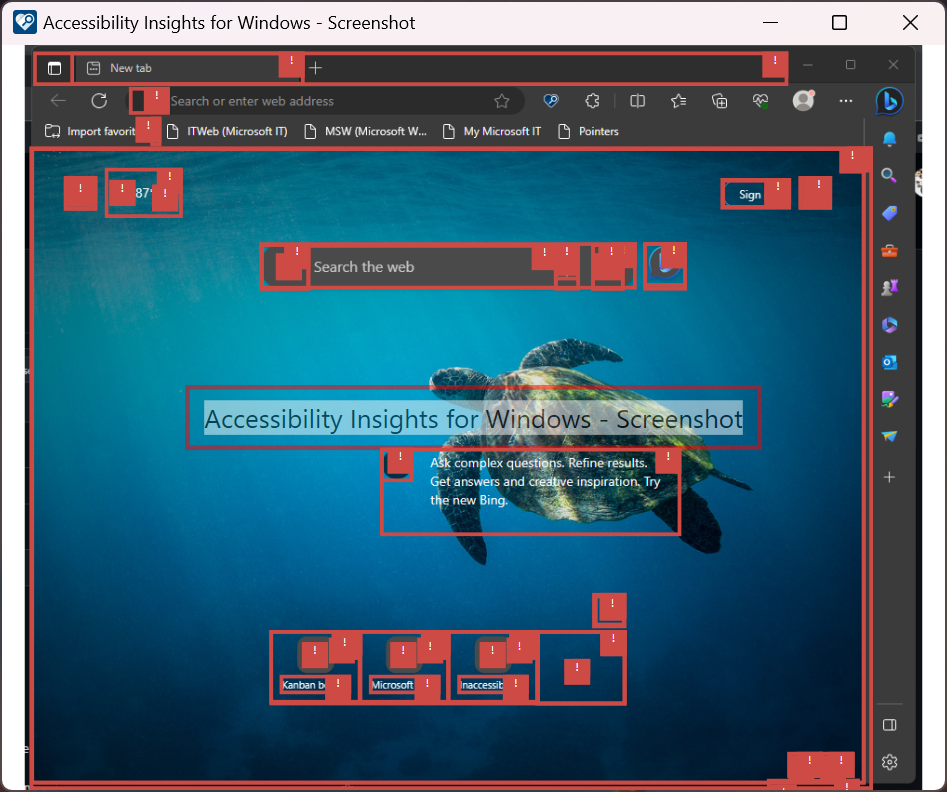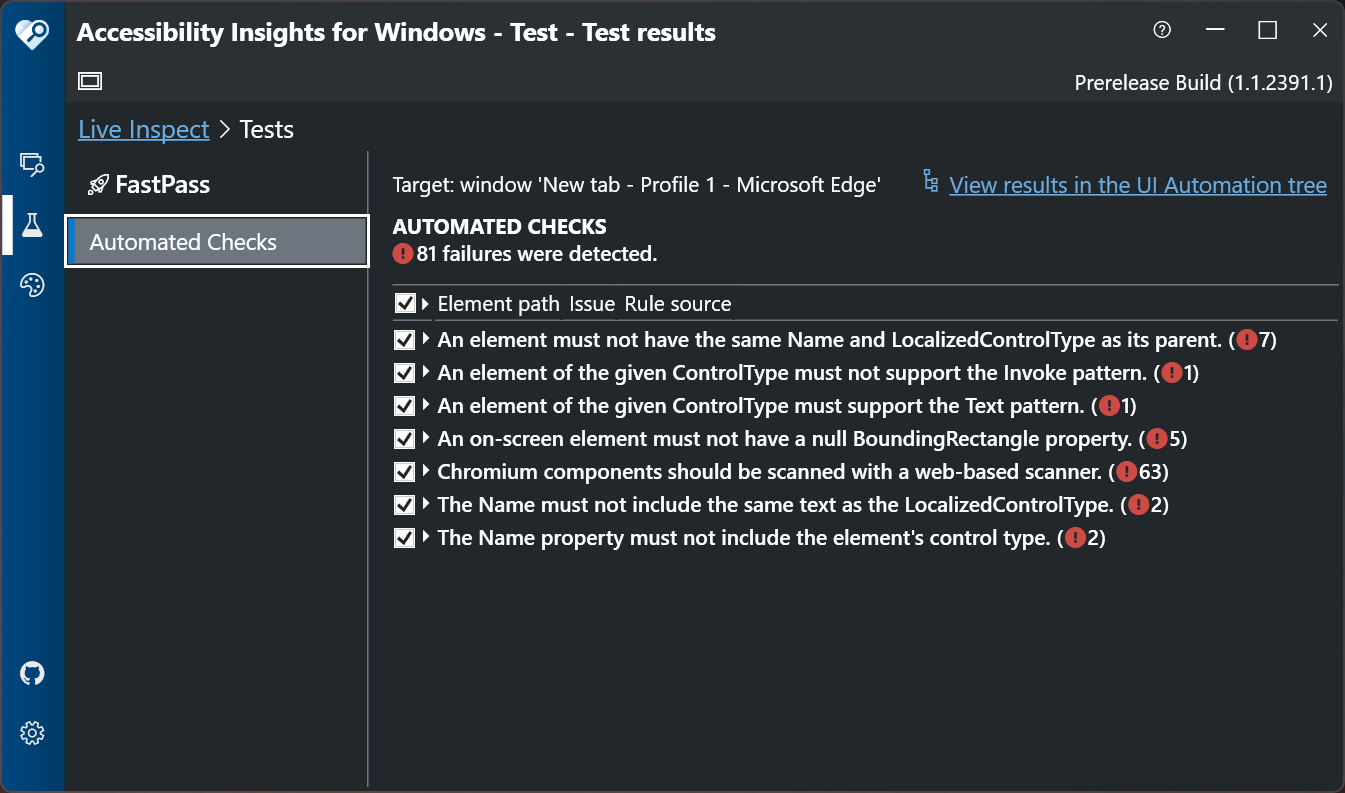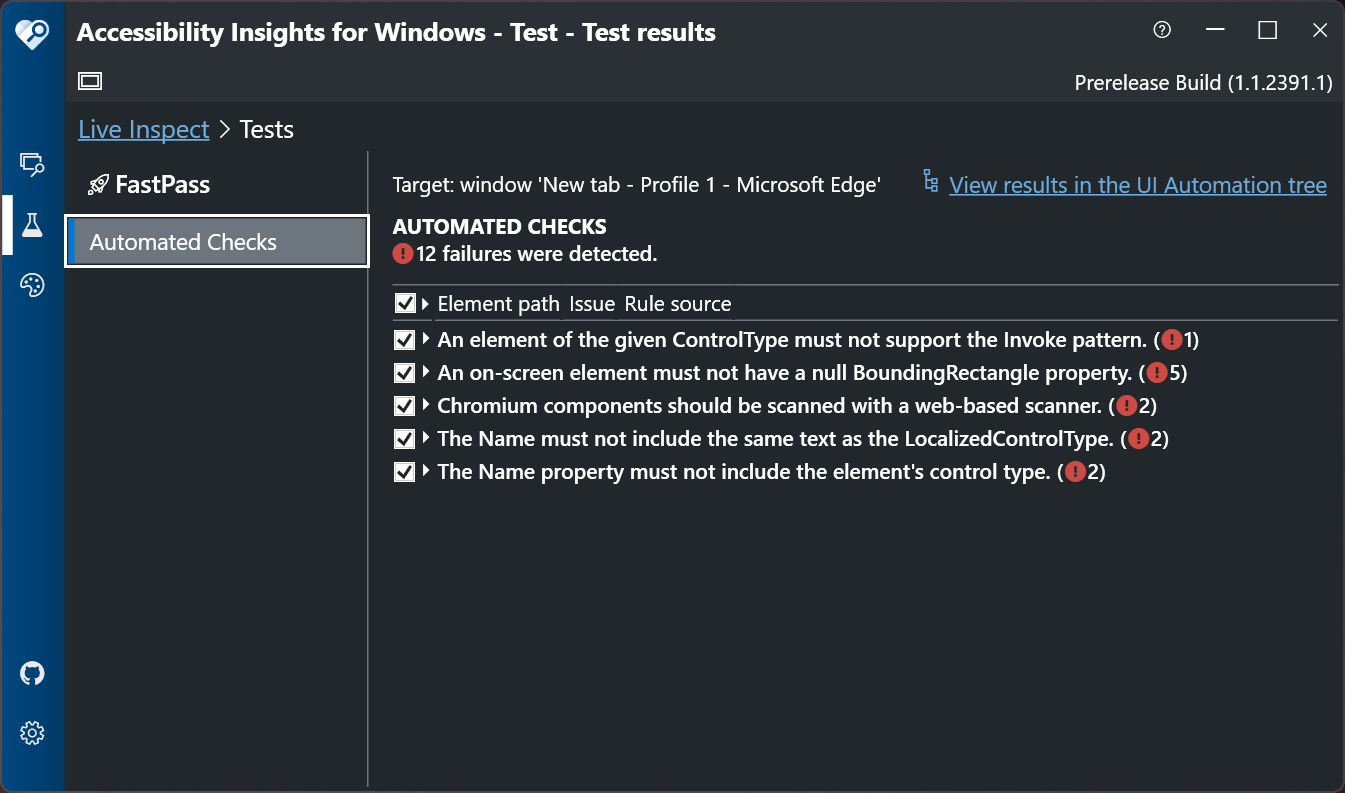New issue
Have a question about this project? Sign up for a free GitHub account to open an issue and contact its maintainers and the community.
By clicking “Sign up for GitHub”, you agree to our terms of service and privacy statement. We’ll occasionally send you account related emails.
Already on GitHub? Sign in to your account
[Feature Request] Make scans against Chromium-based UIs more actionable #836
Comments
|
This issue has been marked as ready for team triage; we will triage it in our weekly review and update the issue. Thank you for contributing to Accessibility Insights! |
|
Triaged with the team. |
…871) #### Details This PR is 1/2 of addressing #836. It includes the following commits/changes, which can be reviewed separately: - 27295d6 adds a new sample project to the tools repo that uses a minimal webview2. - b007694 adds the `ChromiumComponentsShouldUseWebScanner` rule and a new e2e test leveraging the new web view sample added in this PR. ##### Motivation Addresses issue #836 ##### Context This PR only adds the new rule logic but does not do the work to suppress any further errors in descendants of the root "Chrome" element (hence why there are 35 expected errors in the end to end test instead of just 1). A future PR will add the suppression logic separately. #### Pull request checklist <!-- If a checklist item is not applicable to this change, write "n/a" in the checkbox --> - [x] Addresses an existing issue: [#0000](#836)
|
This issue requires additional investigation by the Accessibility Insights team. When the issue is ready to be triaged again, we will update the issue with the investigation result and add "status: ready for triage". Thank you for contributing to Accessibility Insights! |
|
After discussion in Windows triage, this will require some fundamental changes. We feel this needs to be treated as a full feature and not as a kluge fix. |
|
This issue requires additional investigation by the Accessibility Insights team. When the issue is ready to be triaged again, we will update the issue with the investigation result and add "status: ready for triage". Thank you for contributing to Accessibility Insights! |
This comment was marked as spam.
This comment was marked as spam.
This comment was marked as spam.
This comment was marked as spam.
#### Details As called out in #836, the `ChromiumContentShouldUseWebScanner` has caused a lot of confusion. This PR aims to reduce that confusion. It does the following: - The `ChromiumContentShouldUseWebScanner` rule will now trigger _only_ on Chromium-generated `Document` elements - Other rules are disabled on elements that are Chromium-generated `Document` elements or any of their descendants - Future rules default to being disabled on elements that are Chromium-generated `Documents` or any of their descendants. The default behavior can easily be overridden - Where needed for unit tests with strict `mock`s, provide test constructors that allow unit tests to isolate the class under test from the Chromium suppression ##### Motivation Address #836, make the `ChromiumContentShouldUseWebScanner` rule less intrusive ##### Attachments [BeforeAndAfter.zip](https://github.com/microsoft/axe-windows/files/12101240/BeforeAndAfter.zip) contains 2 `a11ytest` files - `Before.a11ytest` contains scan results from Edge before this change - `After.a11ytest` contains scan results from Edge after this change Here are how the numbers line up Message | Count before | Count after | Count of Chromium elements --- | --- | --- | --- An element must not have the same Name and LocalizedControlType as its parent | 7 | 0 | 7 An element of the given ControlType must not support the Invoke pattern | 1 | 1 | 0 An element of the given ControlType must support the Text pattern | 1 | 0 | 1 An on-screen element must not have a null BoundingRectangle property | 5 | 5 | 0 Chromium components should be scanned with a web-based scanner | 63 | 2 | 63 The Name must not include the same text as the LocalizedControlType | 2 | 2 | 0 The Name property must not include the element's control type | 2 | 2 | 0 Things to note on this table: - There are 2 Chromium documents on the page--one for the HTML content and one for the search button. This is an implementation detail of the search button - Only the 2 Chromium documents are counted in "Count after". The 61 omitted elements are children of one of the two Chromium documents - For all other columns. "Count before" - "Count after" = "Count of Chromium elements". This is as expected If you open `After.a11ytest` and inspect the children of the Chromium documents, the UIA properties are reported but no tests were run. That's exactly what this change was intended to do. ##### Screenshots Here are visual representations of the test results with all test results displaying. Notice the difference in the HTML document space: File | Snapshot (click to enlarge) | Test Results (click to enlarge) --- | --- | --- Before |  |  After |  |  ##### Context <!-- Are there any parts that you've intentionally left out-of-scope for a later PR to handle? --> <!-- Were there any alternative approaches you considered? What tradeoffs did you consider? --> #### Pull request checklist <!-- If a checklist item is not applicable to this change, write "n/a" in the checkbox --> - [x] Addresses an existing issue: #836
|
The Chromium rule now triggers exactly once for each Chromium Document. All rules are suppressed for elements within the Chromium Document |
|
Released as part of 2.2.0. Closing as complete. |
Is your feature request related to a problem? Please describe.
This issue is based on discussion with @RobGallo and @DaveTryon after several customer interactions where users attempting to scan apps that are Chromium-based get confused.
The most common case is a user trying to scan a browser (Edge, Chrome, etc) with their page loaded, but we've also seen cases where a user has their own Windows app that embeds Chromium (eg, via Electron or WebView2).
There are two related problems that happen when a user does this:
BoundingRectangleNotNullviolations). Users can't do anything about these, but we don't currently treat them as framework issues.Describe the solution you'd like
Rob and I think we'd ideally handle this on the axe-windows side similarly to how we treat old edge - create a rule which specifically detects an embedded chromium instance (via FrameworkId "Chome") and present a specific error that directly instructs users to scan the contents of the browser with a web-based scanner. Such a rule should probably somehow suppress any further errors in descendants of the root "Chrome" element - this will require some new form of handling, we don't currently have any other rules that do this type of subtree suppression.
It's a little questionable to call this an "Error" since we don't really want to treat it as an error to use a WebView2 at all, but we don't really have a better means to present actionable feedback to a user about needing an extra step for scanning such a component. I think that a single actionable error would clearly be a lot better than the current case of "dozens or hundreds of inactionable errors", though.
Describe alternatives you've considered
BoundingRectangleNotNullviolations that are consistently present regardless of page content. We did some initial investigation and think this is probably an issue on the Chromium side rather than the WebView2/MSAA_Proxy side, but didn't nail down an exact location. If we wanted to follow up on this, good contacts to reach out to for more context would be the folks marked as the Chromium windows accessibility platform OWNERS. However, we think pushing on these are pretty low priority; the issues themselves are such low severity that we think it would be hard to get traction on them, so if we end up making the proposed rule above that would mask them anyway, it doesn't feel worth the effort to try to drive them to resolution.Additional context
n/a
The text was updated successfully, but these errors were encountered: